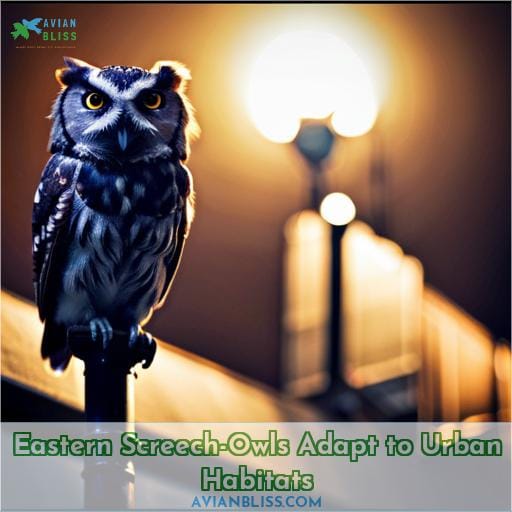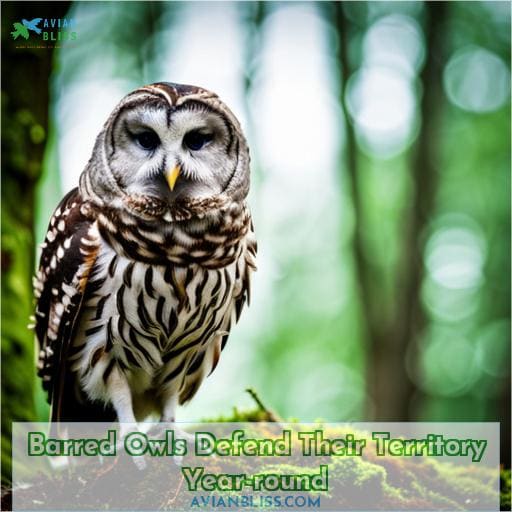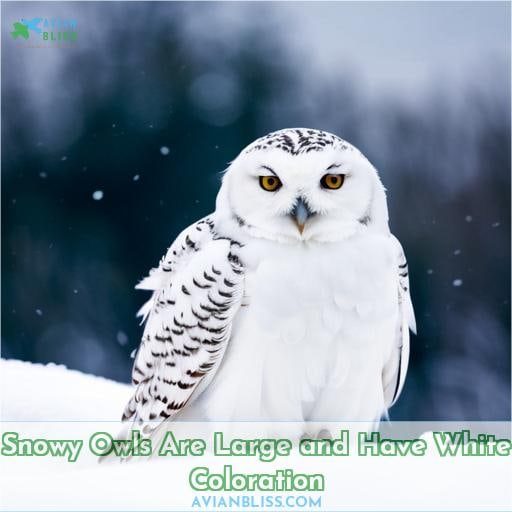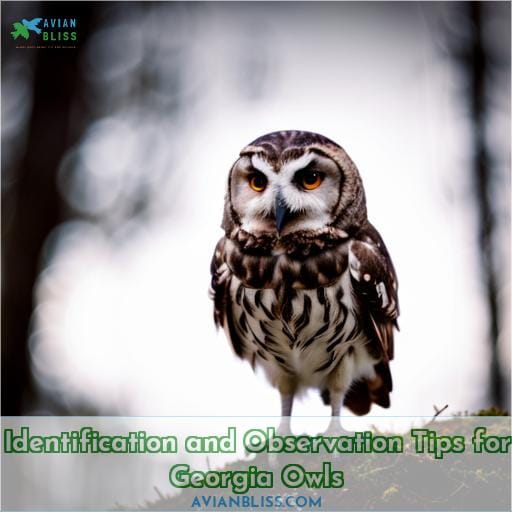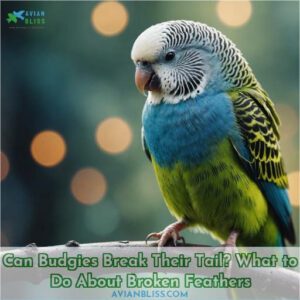This site is supported by our readers. We may earn a commission, at no cost to you, if you purchase through links.
 An owl’s call in the night is one of nature’s most beautiful sounds. Georgia owls, with their wide variety of hoots and trills, are no exception.
An owl’s call in the night is one of nature’s most beautiful sounds. Georgia owls, with their wide variety of hoots and trills, are no exception.
From great horned owls’ deep “hoo-hoo” calls to barn owls’ eerie screeches and snowy owl’s soft whistles – learn all about Georgia owl sounds here! We’ll cover range maps and tips for identification as well as share some interesting facts about each species – from behavior patterns to preferred habitats.
So get ready for an educational journey through Georgia’s enchanting avian world!
Table Of Contents
- Key Takeaways
- Top 5 Owl Species Found in Georgia
- Characteristics and Habits of Georgia Owls
- Eastern Screech-Owls Adapt to Urban Habitats
- Barred Owls Defend Their Territory Year-round
- Northern Saw-whet Owls Are Rare Winter Visitors
- Snowy Owls Are Large and Have White Coloration
- Identification and Observation Tips for Georgia Owls
- Owls of Georgia: Leave a Comment to Share Your Sightings
- Conclusion
Key Takeaways
- Georgia owls have a wide variety of hoots and trills.
- Each species of owl in Georgia has its own unique sounds.
- Listening for owl calls is the easiest way to identify different owl species in Georgia.
- Range maps, photos, and vocalizations can help identify local owl species.
Top 5 Owl Species Found in Georgia
Exploring the diverse world of Georgia’s owls, you’ll encounter some of the region’s most captivating species. From the majestic Great Horned Owl to the haunting calls of the Barn Owl, the Burrowing Owl’s day-and-night activity, the enigmatic Long-eared Owl, and the Short-eared Owl’s unique daylight hunting habits, Georgia offers a rich tapestry of owl species to discover.
Great Horned Owl
You’ll be captivated by the majestic presence of the Great Horned Owl as it soars through the night, its large wingspan and fierce appearance embodying both power and grace.
-
Adaptability: The Great Horned Owl is a common sight in Georgia, making it a versatile and adaptable species, able to thrive in a variety of habitats.
-
Predatory Prowess: With its hoots echoing through the Georgia woods, the Great Horned Owl is a formidable predator, known for its ability to take down larger animals as part of its diet.
-
Nocturnal Mastery: This owl excels in hunting during complete darkness, utilizing its sharp vision and silent flight to surprise its prey.
-
Early Breeding: In Georgia, these owls start laying their eggs in January or February, making them early breeders in the region.
Barn Owl
To catch a glimpse of the elusive Barn Owl, imagine a silent, ghostly figure gliding through the moonlit night. Its heart-shaped face is illuminated by the soft glow of the night sky. Barn Owls are masters of the nocturnal realm, known for their eerie screeching calls that pierce the quiet darkness.
These owls are well-adapted to urban environments, making sightings in Georgia’s cities and towns more common than one might expect. Their distinctive appearance and vocalizations make them stand out among the diverse owl species of Georgia.
This offers a unique opportunity for owl enthusiasts to experience the magic of these nocturnal creatures.
So keep your ears tuned and your eyes peeled for the enchanting Barn Owl in the urban landscapes of Georgia.
Burrowing Owl
If you venture into open fields or grasslands, keep an eye out for the petite and diurnal burrowing owl.
-
Daytime Dweller: Unlike many owls, burrowing owls are active during the day, making them easier to spot in well-lit environments.
-
Burrow Builders: True to their name, these owls are skilled excavators and create their own burrows or occupy abandoned ones in the ground.
-
Social Owls: Burrowing owls are known for their social behavior and often live in colonies, making them a unique owl species in terms of their social structure.
-
Distinctive Appearance: With their long legs and upright posture, they stand out among owls. Their brown and white plumage provides excellent camouflage in their habitat.
-
Vocal Communicators: While not as vocal as some other owl species, burrowing owls do have a range of calls and vocalizations, including soft chattering and hissing sounds.
Observing these charming burrowing owls in the Georgia landscape can be a rewarding experience, especially when you’re equipped with owl identification techniques and owl photography tips to capture their unique behavior and habitat.
Long-eared Owl
Step into the world of the Long-eared Owl, known as the phantom of the night. With their unique hooting patterns and striking appearance, they captivate owl enthusiasts in Georgia. Explore their behavior, habitat, sightings, and conservation efforts for a deeper understanding of these magnificent creatures.
Short-eared Owl
Explore the wide-open landscapes where they roam during daylight, occasionally revealing themselves with their distinctive hunting style. The Short-eared Owl is renowned for hunting during the day. With horn-shaped feather tufts, these owls are often seen flying low over open grasslands and marshes.
| Short-eared Owl Behavior | Daytime hunting, ground nesting, hovering flight |
|---|---|
| Owl Identification Tips | Look for rusty plumage and yellow eyes |
| Owl Conservation | Protect grassland habitat |
Characteristics and Habits of Georgia Owls
Exploring the characteristics and habits of Georgia owls, you’ll find that Great Horned Owls are renowned for their imposing size and fierce appearance, while Barn Owls are true night owls that favor open areas.
Burrowing Owls, on the other hand, are active day and night, and Long-eared Owls are skilled rodent hunters.
Great Horned Owls Are Large and Fierce-looking
Glimpse their large, imposing frames drifting through Georgia’s night skies, for Great Horned Owls are the fierce monarchs ruling these darkened hours. With intimidating yellow eyes and ear tufts like horns, these powerful raptors silently patrol the night.
Barn Owls Are Nocturnal and Prefer Open Areas
When it comes to nocturnal hunters, Barn Owls truly excel. Their preference for open spaces makes them the silent nighttime predators of choice.
Barn Owls are nocturnal predators that rely on acute hearing to hunt rodents at night. They are found in open areas and are less active in wooded or forested areas. These owls have unique screechy calls that help identify their presence in the area.
They are attracted to barns and sheds, where they seek out roosting and nesting spots.
The screeching calls of the Barn Owl reveal its presence as it soars over open fields at night, seeking rodents with its keen sense of hearing. Though shy, these effective nocturnal hunters are a fascinating part of the landscape.
Burrowing Owls Are Active Day and Night
Dig up why burrowing owls hunt both day and night in open areas:
- Owl Behavior: Burrowing owls adapt to diurnal and nocturnal hunting, utilizing the advantages of both.
- Nocturnal Hunting: Their nighttime escapades focus on rodent prey.
- Georgia Birdwatching: Observing burrowing owls in action enriches your Georgia birdwatching experience.
Long-eared Owls Prey on Rodents
You’ll often hear their low, rhythmic hoots as Long-eared Owls snatch up mice and voles in open fields. With keen hearing guiding their hunts, these medium-sized owls thrive by targeting small rodents as their preferred prey.
Short-eared Owls Hunt in Daylight and Are Found in Open Landscapes
You notice Short-eared Owls often hunting in open daylight as they sweep across open terrain.
- Wings look long and slender in flight.
- They hunt low, coursing over grasslands.
- They migrate south in winter from northern breeding grounds.
- They nest on the ground amid tall vegetation.
- They make high-pitched barking sounds.
The Short-eared Owl’s preference for hunting in open areas during daylight hours helps distinguish it from other owl species you may encounter. By observing an owl’s behavior and habitat, you can begin identifying which species you see.
Eastern Screech-Owls Adapt to Urban Habitats
Little owlets snoozing in backyard nest boxes show how Eastern Screech-Owls thrive near people’s homes. Weaving through the shadows of night, these adaptable owls scout for tasty morsels in insect-rich suburbs.
Listening to their haunting hoots connects us to the mystery of the natural world. Don’t be surprised if you glimpse these nocturnal hunters scanning the darkness from backyard trees. Unlike most owls preferring remote forests, they nest in old woodpecker holes and stump hollows amid neighborhood greenery.
Their camouflaged feathers and muted hoots help them blend into the urban landscape. Next time the sun sets, open your senses to discover if an Eastern Screech-Owl’s mesmerizing sounds echo through your neighborhood.
Trace the hoots to appreciate how these resourceful owls settle so comfortably among us.
Barred Owls Defend Their Territory Year-round
Grab your binoculars, because barred owls are hooting and defending their territory in Georgia’s forests year-round. These large, nocturnal owls with distinctive horizontal barring on their chest and vertical bars on their belly can be found inhabiting mature forests and swamps across the state.
Barred owls are highly territorial and use a variety of vocalizations to defend their home ranges of around 500 acres from intruders. With calls described as Who cooks for you? Who cooks for all?, barred owls aggressively hoot to proclaim territory ownership.
By hooting, the owls also attract mates and communicate with their family group members. Barred owl calls can be heard year-round as they defend prime nesting and hunting grounds in their wooded habitat.
From deep hoots to caterwauls and screeches, listening for barred owl vocalizations is a great way to detect their presence in Georgia’s forests.
Keeping an ear out for barred owls is the best way to detect their presence, as these secretive raptors blend into their wooded surroundings. Their calls reveal both their location and their efforts to maintain an exclusive territory rich in prey like mice, voles, and insects.
Northern Saw-whet Owls Are Rare Winter Visitors
Suddenly, Northern Saw-whet Owls mysteriously creep into Georgia as an omen of winter’s arrival. These rare nocturnal visitors are seldom seen, yet occasionally heard, when they migrate across the state between November and March.
Their eerie, repetitive toos reveal a presence that lingers through the cold months before vanishing again.
Conservation volunteers carefully monitor and track sightings of these elusive winter owls. As Georgia’s forests transform with the seasons, Northern Saw-whets temporarily find haven within the mix of evergreen woods, open fields, and wetland edges until continuing northward come spring.
Often confused with young Horned Owls, these migratory raptors are diminutive in size, measuring just 6 to 7 inches tall. However, their scientific name Aegolius acadicus hints at an ancient, primal spirit.
Perhaps by listening for Northern Saw-whet Owls in winter, we may gain wisdom and perspective during nature’s cycles of change.
Snowy Owls Are Large and Have White Coloration
You’re startled to glimpse an enormous ghostly white owl perched on a tree, its piercing yellow eyes tracking your every move. These Snowy Owls are rare winter visitors to Georgia, migrating south from the arctic when food is scarce.
Their white plumage helps them blend into snowy environments, though individuals can exhibit dark speckling.
As Georgia’s largest owl, they have a wingspan exceeding four feet! Though primarily nocturnal hunters, they may forage heavily during daylight in unfamiliar surroundings. While Snowy Owls prefer open terrain, they adapt to utilize trees and posts for scanning and pouncing on prey.
If you spot this hulking, snow-colored raptor, consider yourself fortunate – not all are granted an audience with such an imposing predator. Take a moment to appreciate this remarkable owl before it returns north come spring.
Identification and Observation Tips for Georgia Owls
Owls can be difficult to identify by sight, so listening for their distinctive calls is often the easiest way to recognize different species in Georgia. Pay close attention to range maps for each owl to determine if they might be found near you, and use audio recordings along with photos to help match the sounds and visuals of owls that frequent your area.
You’ll have the best luck observing owls in the early morning or evening hours as they perch on poles, bare branches, and other exposed perches while hunting.
Identifying Owls by Sound
Listen closely as owls hoot since identifying them by sound is easier than sight. Each species has unique vocalizations to learn. Study owl calls and range maps. Go owl watching at night when they are most vocal.
Use audio birding guides and owl posters showing species distribution. Become an expert in identifying owls by sound through dedicated listening.
Paying Attention to Range Maps
View range maps to see which owls may be in your area before going out to listen and look for them. This will allow you to focus on species likely present based on habitat preferences and distribution.
Consult records of owl sightings to further pinpoint species in your location. Understanding species’ vocalizations beforehand will help with identification.
Using Photographs and Sounds for Identification
Since owl species have distinct calls, comparing recordings to known owl vocalizations aids identification.
- Study range maps to know which owls may be present.
- Listen to audio recordings to match calls to species.
- Examine photos of owls in field guides for visual identification.
- Use apps like Merlin Bird ID that incorporate sight and sound.
Careful observation and listening are key to identifying the owls sharing your Georgia woods.
Preferred Perching Spots and Active Hours of Owls
You’d spot them perched on poles or leafless trees while you’re jogging in the early hours. Owls prefer those lofty perches for optimal hunting visibility. Their nocturnal habits make early mornings or nights prime times to catch a glimpse.
Look for large silhouettes on telephone poles, bare branches, and fence posts. Dawn or dusk offers your best chance to observe owl behavior and fascinating hunting patterns.
Owls of Georgia: Leave a Comment to Share Your Sightings
Share your sightings below to help others learn which owls you’ve spotted in Georgia. Our state is home to a fascinating diversity of owl species with unique vocalizations, habitats, and behaviors.
To help expand our community’s knowledge, please leave a comment describing:
- The owl species you observed
- The location and habitat where you saw it
- The owl’s distinguishing features and behaviors
By sharing sightings, we gain valuable data on owl species in Georgia like population trends, range maps, migration patterns, and conservation needs. Your comments help create a collective knowledge base that inspires deeper understanding and enables wise protection of these captivating creatures.
Let’s keep the conversation going to advance our appreciation of owls in our state.
Conclusion
Soaring through the night sky, Georgia’s owl species bring with them a unique symphony of hoots, screeches, and other vocalizations. From the Great Horned Owl’s deep, low hoots to the Barn Owl’s distinctive screeching call, each species has its own distinct sounds and behaviors.
With a little knowledge of the range maps, photographs, and vocalizations for each species, you can easily identify the owls in your area.



